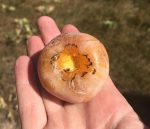

Regarding the chemical characteristics, there were no differences among the cultivars’ pH and soluble solids content however, in general, the ‘Pomelo’ persimmon fruit presented less titratable acidity and a higher maturation index rating. The fruits’ diameter growth behavior was evaluated and it was observed that all cases were defined as double sigmoidal, defined by three single phases. Nevertheless, there were no differences among the cultivars regarding productivity, which could be due to the persimmon fruits physical characteristics. However on ‘Rubi’, ‘Fuyu’ and ‘Rama Forte’ persimmons trees were found the largest number of female flowers, fruits fixation index and number of fruits per branch.

It could be observed that only ‘Pomelo’ persimmon trees presented male flowers.
#Persimmon seed weather indicator full
Despite significant differences between cultivars in the early and intermediate stages of the plants development such as branch development, full blossom and fruiting’s onset, the time required between the fruit’s pruning and harvesting was similar among the cultivars. The main phenological phases of persimmons trees were evaluated. The persimmon cultivars studied were ‘Pomelo’, ‘Rama Forte’, ‘Fuyu’ and ‘Rubi’. The aim of this study is to evaluate the phenology, yield and fruit physicochemical characteristics of four persimmon cultivars (Diospyros kaki L.) in São Paulo’s Midwest countryside, Brazil. Thus, this study will provide the dissemination of knowledge of persimmon cultivars among growers and researchers. Correct identification of phenological stages is of great importance for the characterization and management in persimmon. In addition, the phenological records over two growing seasons in the National Field Genebank for Persimmon (NFGP) were used to draw a schematic representation of principal growth stages. To better understand these phenological growth stages, we next provided illustrative photos with codification and description in persimmon. The consequent reproductive phenology contained the four following stages, inflorescence emergence stage (5), flowering stage (6), fruit development stage (7), and fruit maturity stage (8). We first investigated the vegetative phenology, including: bud development stage (0), leaf development stage (1), shoot development stage (3), and senescence and rest stage (9). The principal growth stages of persimmon were divided into the vegetative and reproductive phenology. In this study, we characterized persimmon phenological growth stages in four persimmon cultivars containing two important morphological traits of sexuality and astringency using the BBCH (Biologische Bundesanstalt, Bundessortenamt Chemische Industrie) scale. Phenology of fruits has attracted the interest of many breeders, growers, and researchers for accurately schedule timing of horticultural managements, but detailed and specific scale for persimmon, especially for the pollination-constant non-astringent (PCNA) and androecious persimmons, remain non-available. A winter with heavy snow that needs shoveling, is in store if you see the spoon.Persimmon (Diospyros kaki Thunb.) is one of the most important fruit that is grown commercially worldwide including the East Asia and Mediterranean regions, and it has been cultivated for its fruit with high nutritional values.A bitterly cold winter that you could “cut like a knife”… is coming with the knife.A mild winter with light snow would be on the way if you find a fork.There are three images that could find inside your persimmon seed: a spoon, knife, or fork. He showed us that if you take a persimmon seed, slice it in half, it would reveal an image that is said to predict the winter.

Our neighbor, Bob, was over one day and picked up a persimmon that had fallen to the ground. What you see in the persimmon can foretell the weather.
#Persimmon seed weather indicator how to
This year, we were asked if we knew how to predict the winter weather season, from our persimmon seed kernels. The next year, we worked on baking with persimmons. We weren’t sure exactly what they were until, one day in the fall, we tasted one and then we knew exactly what we had- a persimmon. The first year we lived on our property, we discovered we had a few trees with small, orange, crab-apple sized fruits on them. Do you see the “spoon” in this persimmon seed?


 0 kommentar(er)
0 kommentar(er)
